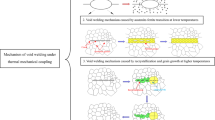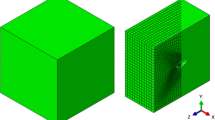Abstract
Crushing and diffusion welding are two critical healing stages of interior void defects in heavy forgings. The healing result depends on many factors during the forging process, such as stress, temperature, deformation and type of material, while the void diffusion welding condition is still not well known at the present. This paper is concerned with the deformation welding condition of the closed void interface in heavy ingot during the hot forging process. A void crushing experiment is carried out to recognize the microstructure of the closed void interface. According to the healing mechanism at high temperature, a new physical simulation model is setup to study the deformation welding process of the closed void interface based on the theory of atom diffusion and the interface contact mechanics prototype. Compared with the experimental results, the influence of deformation degree, forming temperature and holding time on the welding quality is discussed, and then the deformation welding condition of closed void interface is presented. The proposed condition helps to improve forging technology and product quality.
Similar content being viewed by others
References
Jin Ning. Investigation of collapse and welding law of cavities and porous defects in large forgings, and development of high temperature moiré grids [D]. Beijing: Department of Mechanical Engineering, Tsinghua University, 1996 (in Chinese).
Bi Qing-xia. Study on hole seaming of large forgings by diffusing under high temperature [D]. Qinhuangdao: Institute of Mechanical Engineering,Yanshan University, 2004 (in Chinese).
Huang Hua-gui, Du Feng-shan, Xu Zhi-qiang. Factors affecting diffusion welding of internal porosity defects in heavy forgings [J]. Journal of Iron and Steel Research, 2007, 19(11): 55–59 (in Chinese).
Park C Y, Yang D Y. A study of void crushing in large forgings. I. Bonding mechanism and estimation model for bonding efficiency [J]. Journal of Material Processing Technology, 1996, 57(1–2): 129–140.
Park C Y, Yang D Y. A study of void crushing in large forgings. II. Estimation of bonding efficiency by finite-element analysis [J]. Journal of Material Processing Technology, 1997, 72(1): 32–41.
Park C Y, Yang D Y. Modelling of void crushing for large-ingot hot forging [J]. Journal of Materials Processing Technology, 1997, 67(1–3): 195–200.
Zhong Yue-xian, Yuan Chao-long, Ma Qing-xian. Structure growth mechanism for interior cracks in selfhealing [J]. Journal of Tsinghua University (Science and Technology), 2002, 42(4): 512–515 (in Chinese).
Ma Qing-xian, Wang Zhi-cheng, Zhong Yue-xian. The mechanism of faults originating from inclusions in the plastic deformation processes of heavy forging [J]. Journal of Material Processing Technology, 2002, 123(1): 61–66.
Yuan Chao-long, Zhong Yue-xian, Ma Qing-xian. Mimic biology research on self-recovering mechanism of cavity type crack [J]. Science in China Series E, 2002, 45(5): 531–540 (in Chinese).
Marsion L W, Price S, Mees J, et al. Improved in-service performance of large forged back up rolls through the development of steel chemistry [C]. Proceedings of Rolls 2000+ Advances in Mill Roll Technology. Birmingham, UK: IOM Communications Ltd, 1999: 281–291.
Zhao Xian-chun. Research on Cr5-type forged steel for backup roll [J]. Heat Treatment of Metals, 2003, 28(6): 26–28 (in Chinese).
Author information
Authors and Affiliations
Corresponding author
Additional information
Foundation item: the National Natural Science Foundation of China (Nos. 50435010 and 51005197), the National Scientific and Technical Supporting Programs of China (No. 2007BAF02B12), and the Doctor Fund Project of Yanshan University (No. B298)
Rights and permissions
About this article
Cite this article
Huang, Hg., Xu, Sm., Wang, W. et al. Research on voids deformation welding condition for manufacturing of heavy forgings. J. Shanghai Jiaotong Univ. (Sci.) 16, 203–208 (2011). https://doi.org/10.1007/s12204-011-1122-7
Received:
Published:
Issue Date:
DOI: https://doi.org/10.1007/s12204-011-1122-7




